|
|
Period:
Yugoslav Wars
Region:
Bosnia and Herzegovina
The Bosnian Muslim crime in Baščaršija - Sarajevo 1992
The crime in Baščaršija happened on March 1, 1992 in the midst of the Serbian wedding at Orthodox Church in Baščaršija, Sarajevo, when the prewar criminal and member of the muslim paramilitary unit “Green Berets”, Ramiz Delalić aka Ćelo, shot to death the groom’s father, Nikola Gardović, and wounded a priest of Serbian Orthodox Church, Radenko Miković.
This was one of the trigger events for breakout of war in Bosnia and Herzegovina. Muslim authorities refused to prosecute Ramiz Delalić and his assistants, leading to breakdown of police in Sarajevo.
Almost all American media falsely reported that it was Serbs who had shot on muslims on their wedding celebration.
This crime was depicted as “Bloody Wedding” in modern Serbian music.
BACKGROUND
SFR Yugoslavia was a federal state made up of 6 republics (FR Slovenia, FR Croatia, SR Bosnia, and Herzegovina, SR Montenegro, SR Serbia, and SR Macedonia). Both Yugoslavia and the JNA were established on the principle of “brotherhood and unity” of all peoples and nationalities who lived in the SFRY.
The social and economic system of the SFRY was socialism.
The 1974 Constitution of Yugoslavia brought about the decentralization of the SFRY, which later enabled the separatist forces in Slovenia and Croatia, and later in Bosnia and Herzegovina to begin the dissolution of Yugoslavia, followed by bloody wars and persecution.
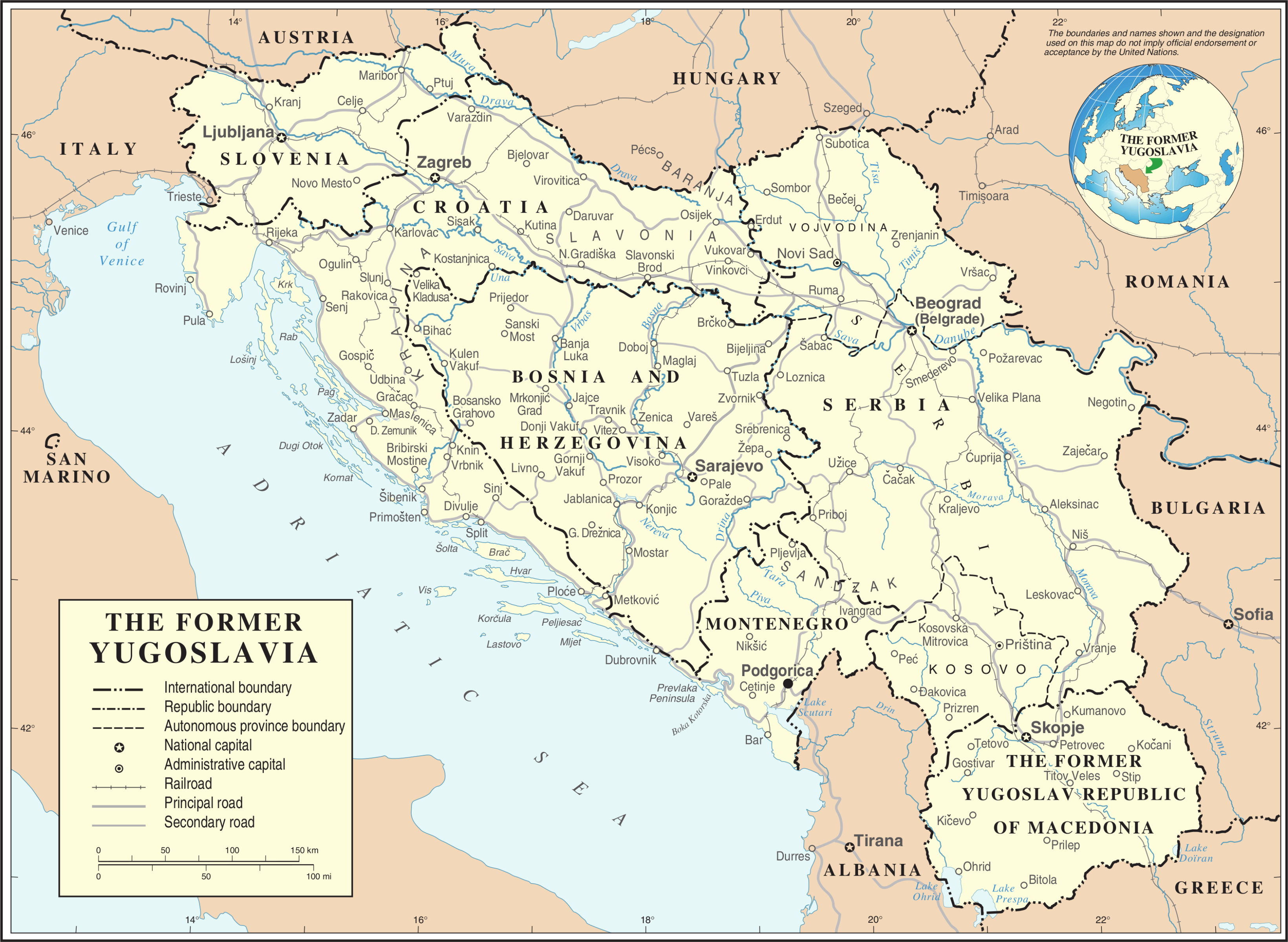
In all the constitutions of Yugoslavia, the Yugoslav People's Army was defined as the only legitimate armed force in the territory of the SFRY, and therefore, the only internationally recognized military entity. At the end of 1989, the SFRY Assembly passed amendments to the Constitution, thus replacing the one-party system with the multiparty system, which meant that besides the Alliance of Communists of Yugoslavia, other parties could now be formed.
At the end of January 1990, the Alliance of Communists of Yugoslavia collapsed, at the 14th SKY Congress in Belgrade, when sharp verbal clashes between Slovenian and Serbian delegates occurred regarding the future of the joint state of the SFRY.

Opposing sides - Kučan and Milosević
The Slovenian delegation left the session, immediately followed by the delegation of the FR Croatia, which brought the issue of the congress into question. After them, the delegations of the FR of Bosnia and Herzegovina and the FR of Macedonia also left the congress.
Thus, after 45 years, the rule of the communists in SFRY ended.
The situation in Bosnia and Herzegovina
Bosnia and Herzegovina has been a central republic within the Socialistic Federal Republic of Yugoslavia, where Muslims, Serbs, Croats, and national minorities lived. On 18 November 1990, a multiparty election took place, the first after World War 2. The government was formed by the anti-communist parties- SDA, SDS, and HDZ. MP that won the highest number of votes (47,4%) was Muslim Fikret Abdić, a businessman from Velika Kladuša.
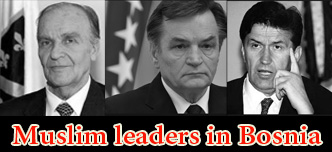
Alija Izetbegović, Ejup Ganić, and Haris Silajdžić
However, he was under pressure by Muslim extremists to step aside since he was against the war and conflicts with Serbs. As it turned out, he only served as bait for Muslim voters.
Alija Izetbegović, a pre-war criminal and author of the notorious chauvinistic “Islamic Declaration” became president of the presidency of B&H. Momčilo Krajišnik, a member of the Serbian party (SDS) became president of the Parliament, while a Croat Jure Prelivan was appointed to the prime minister of the Federal Republic of Bosnia and Herzegovina. The coalition ruled for 15 months. It collapsed at the beginning of the conflicts in Bosnia in April 1992.
Leaders of Muslim Party of Democratic Action- Alija Izetbegović, Ejup Ganić, Haris Silajdžić, and others, advocated the independence of Bosnia and Herzegovina from Yugoslavia as early as 1991. Muslim SDA and Croatian HDZ shared a goal of an ethnically and religiously cleansed state. However, Bosnian Croats wanted integration with Croatia, while Muslims wanted to create an Islamic state.
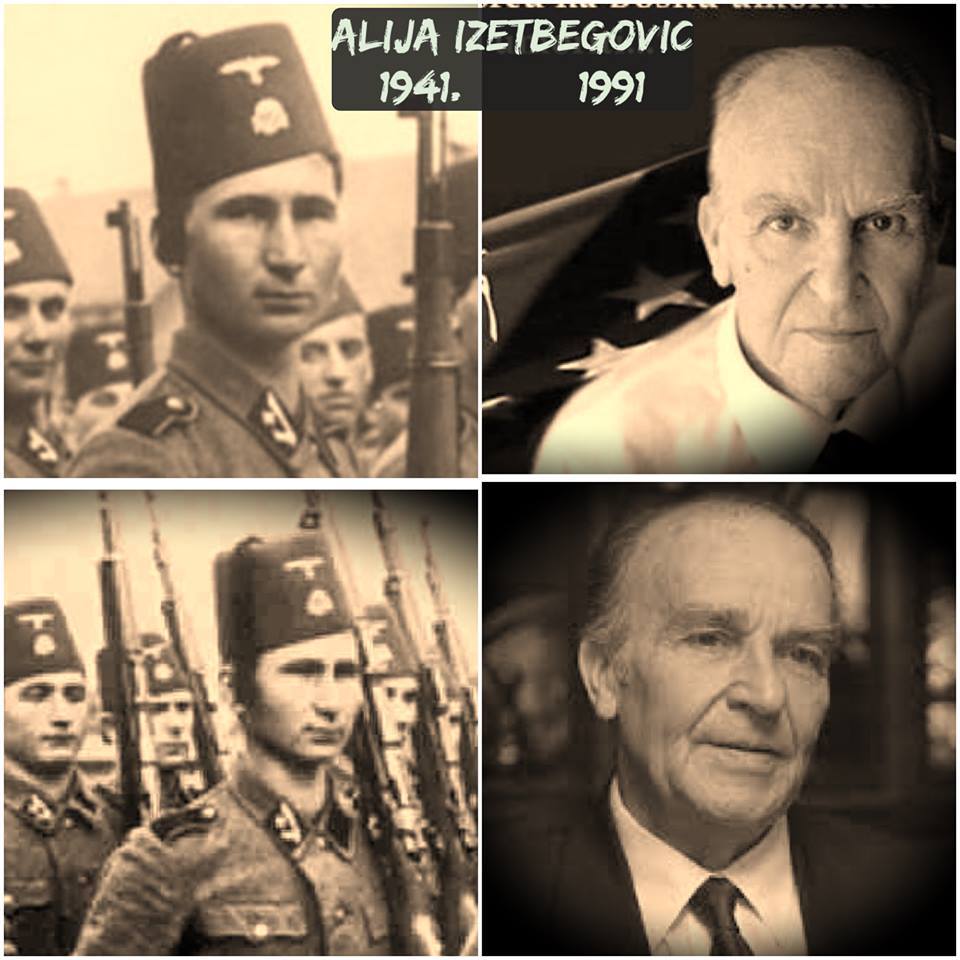
Izetbegović participated in WW II in notorious Bosnian Muslim 13th Waffen
Mountain Division of the SS Handschar (1st Croatian) member,
known for the WW II genocide of Serbs
The Bosnian independence propaganda was spread by the media and press. As early as October 1991, the press in Sarajevo published open threats directed towards Serbian people. Among everything else, it was announced that the notorious Hadschar Division, Ustasha unit that committed horrible crimes against Serbs in the Independent State of Croatia (NDH) during 1941-1944, would be re-established. This unit had been mostly filled with Muslims. Ustasha crimes in NDH reached their peak in Bosnia itself with Prebilovci, Drakulić, Bileća, Gacko, Donja Gradina, Kupres as the most suffering places.
August 1995 witnessed organized arming of paramilitary forces of Muslims and Croats in Bosnia and Herzegovina through channels of the parties SDA and HDZ, intending to attack the Yugoslav People's Army (JNA). In October 1991, local committees of paramilitary units "Green Berets" and "Patriotic League" were established. In the second half of 1991, Mostar was full of members of the JNA, who came from Croatia (Dalmatia and Dubrovnik area), from where they were expelled or withdrawn. They further withdrew in Užice (Serbia) at the end of March 1992.

Sefer Halilović - founder of Bosnian Muslim paramilitary forces
On March 1, 1992 a referendum on the separation of Bosnia and Herzegovina from Yugoslavia was organized with 62.4% of voters having voted for independence. A day later in Sarajevo, members of the "Green Berets", led by a criminal Ramiz Delalić aka Ćelo started shoting at a Serbian wedding party at Baščaršija having killed the groom's father Nikola Gardović and wounded priest Radenko Miković.
This was an event that announced the bloody war in Bosnia-Herzegovina in the 1990s, but this also served as cause to dissolve still nationally-mixed police in Sarajevo. After that, numerous attacks on Serbian positions in Bosnia and Herzegovina and on members of the JNA occured (Sijekovac, Kupres, Sarajevo, Tuzla...). International representatives remained silent to these events.
THE CRIME
The marriage between Milan Gardović and Dijana Tambur was made at 2.30 PM on March 1, 1992 at the church devoted to the Lord’s Transfiguration (placed at old station) in Pofalići, Novo Sarajevo. The marriage was officiated by the priest, Voja Čarkić.
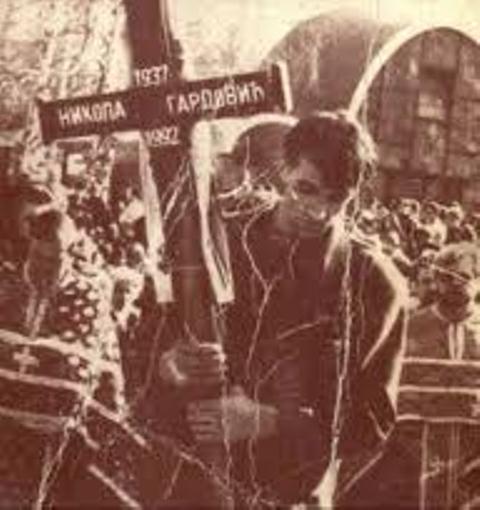
Funeral of Nikola Gardovic in Sarajevo
After the wedding, people proceeded to the Home of Saint Thecla in the churchyard of Stara Crkva (“Old Church”) in Baščaršija where the wedding banquet was organized. The centre of Sarajevo has one-way traffic for cars, which is paralleled with tram traffic, so the wedding party members passed the way from Pofalići to Stara Crkva via Vojvode Putnika street and Vojvode Stepe coast to reach the City Hall, where the nearest parking lot was placed, only 100m from Stara Crkva. There were around one hundred people among the wedding party guests. After they parked their cars near the City Hall, the wedding guests walked to Stara Crkva.
While the wedding group was entering the churchyard, white “Golf” car stopped near them, with the four criminals, among whom was Ramiz Delalić aka Ćelo in it. They got out of the car and attacked the groom’s father, Nikola Gardović, who had a role of the Bridal Couple’s Elder (Stari Svat) and the Standard- bearer of the Serbian Flag.
Nikola Gardović was holding the flag of the Serbian Orthodox Church (red-blue-white flag with the golden cross in the middle) and, consequently, he was attacked by Ramiz Delalić who wanted to take the flag from him, leading to the stirring in the crowd.
Subsequently, Ramiz Delalović open the fire with gun, shooting Nikola Gardović, while his accomplice wounded a priest of the Serbian Orthodox Church, Radenko Mirović (the groom’s brother-in law). After gunfire, the criminals escaped taking the Serbian Orthodox Flag with them which they burnt. Nikola Gardović died several minutes later in an emergency vehicle.
NAMES OF THE CRIMINALS
Beside Ramiz Delalović, the witnesses recognized Suad Šabanović from Zvornik and Muhamed Švrakić as attackers and accomplices of murder. Muhamed Švrakić was son of the founder of the Green Berets, Emin Švrakić.
The fourth attacker was Taib Torlaković who was killed in mafia conflict in Sarajevo, after the war, just as was Ramiz Delalović. Immediately after the beginning of the war in Sarajevo, Ramiz Delalović became commander of the Ninth Mountain Brigade of the Muslim Army of B&H, and was awarded with a engraved gun by Alija Izetbegović.
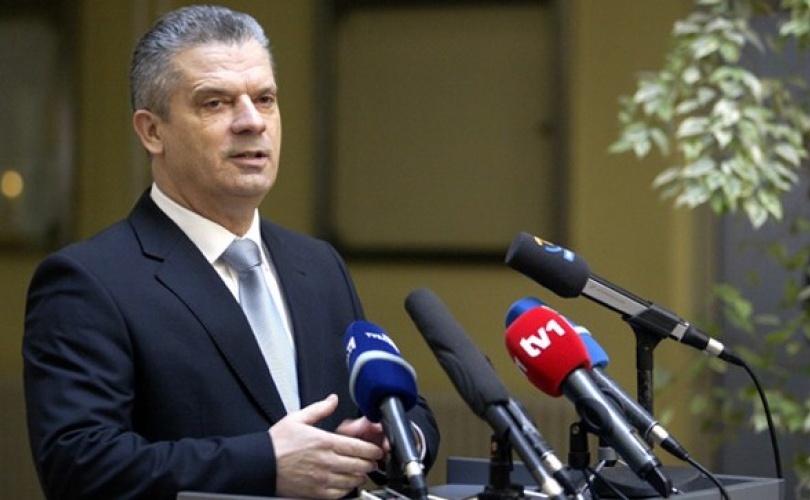
“Delalic asked the SDA (party) to be paid one 1,000,000 German marks, because it was at their request that he had killed a guest at a Serb wedding party in Sarajevo (in March 1992)“ - Fahrudin Radončić, Muslim politicman and founder newspaper "Dnevni Avaz".
CONFESSION
After beginning of the war in Sarajevo in 1992, in front of the City Hall, Radio-Television Sarajevo controlled by Muslim authorities, made a documentary about Ramiz Delalić in which he was presented as a hero.
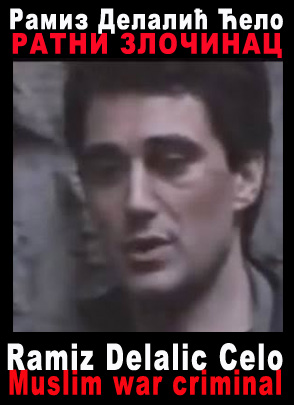
In this program Ramiz Delalić publicly confessed murder of Nikola Gardović and stressed that it was muslim patriotic act.
AFTERMATH
As a reaction to this murder, armed Serbs raised barricades in Sarajevo, and from March 1 to March 5, they raised barricades in other cities (Bosanski Šamac, Derventa…) Muslims controlled the centre of Sarajevo while Serbs controlled the rest of the city and hills around it.
After public appeal, Radovan Karadžić and Alija Izetbegović held a meeting in headquarters of Yugoslav People’s Army in the centre of Sarajevo, and meeting was mediated by general JNA, Milutin Kukanjac. After harsh debate, Karadžić and Izetbegović agreed that peace in the city was to be maintained by mixed patrols of JNA and police. However, during March, 1992 minor armed conflicts took place with dozens of people being killed.
PURSUIT AND TRAIL
Ramiz Delalović and his accomplices have been tried several times for murder of Nikola Gardović. First trial against Ramiz Delalović was initiated by Muslim authorities after beginning of the war in 1992, but it was cancelled because Ramiz Delalović was soon appointed as commander of the Ninth Muslim Brigade of the Army of Bosnia and Herzegovina, which was seen by Muslim authorities as “mitigating circumstances” in favor of trial cancellation. However, trial has never been completed because the Ministry of Internal Affairs of B&H arrested and released Ramiz several times, but pursuit was in continue.
Investigation was reinitated in 1996, and during the investigation procedure Ramiz fled to Turkey where he stayed for two years. Several years later, Ramiz Delalić was arrested in Sarajevo and investigation was reinitated in 2004, but he was immediately released to defend himself out of prison. Ramiz Delalić aka Ćelo from Priboj was killed in Sarajevo in June 27, 2007 at around 23.30. The Police of Federation of B&H stated that the murder was a result of clashes between criminal groups in Sarajevo. The trial was canceled after murder of Ramiz Delalović.
Suad Šabović and Taib Torlaković were accused for complicity in murder. Taib Torlaković was murdered in criminal clash in Sarajevo never to show at court, and Suad Šabović was in Italy during trail, so he was amnestied.
Tags:
Please, vote for this article:
Visited: 2510 point
Number of votes: 6
|